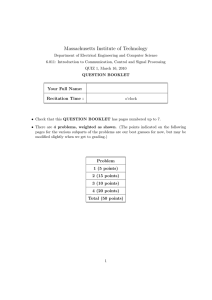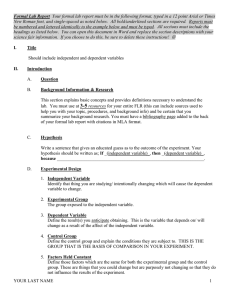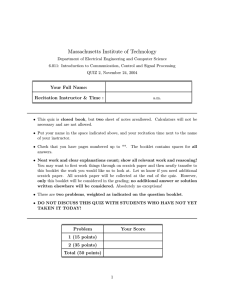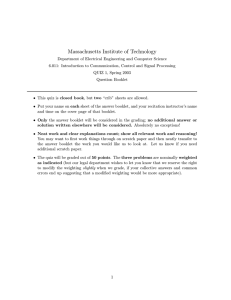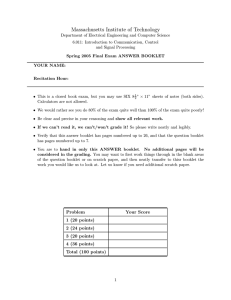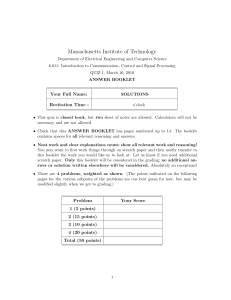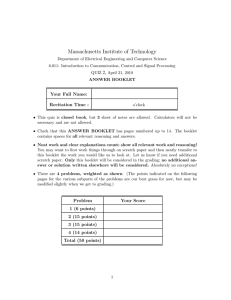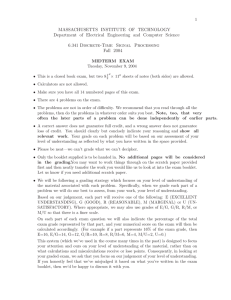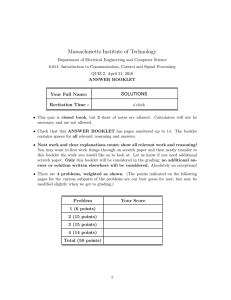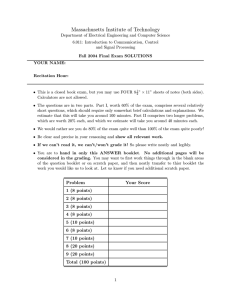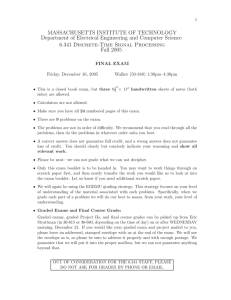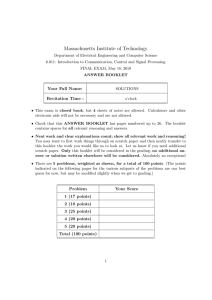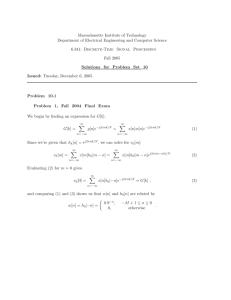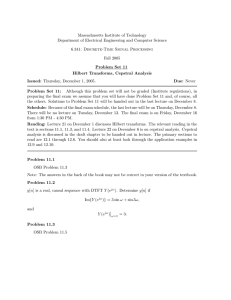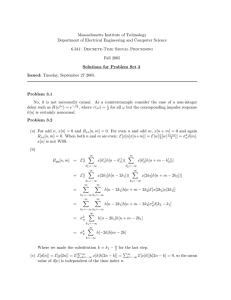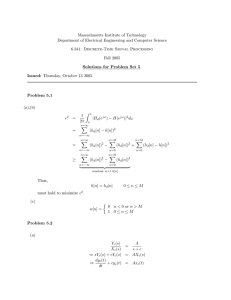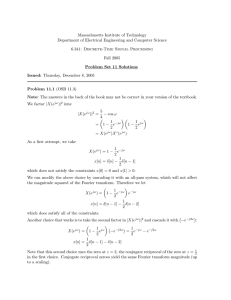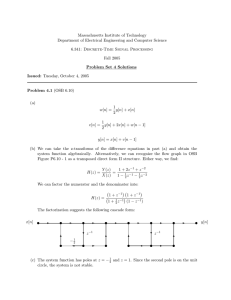Document 13436397
advertisement
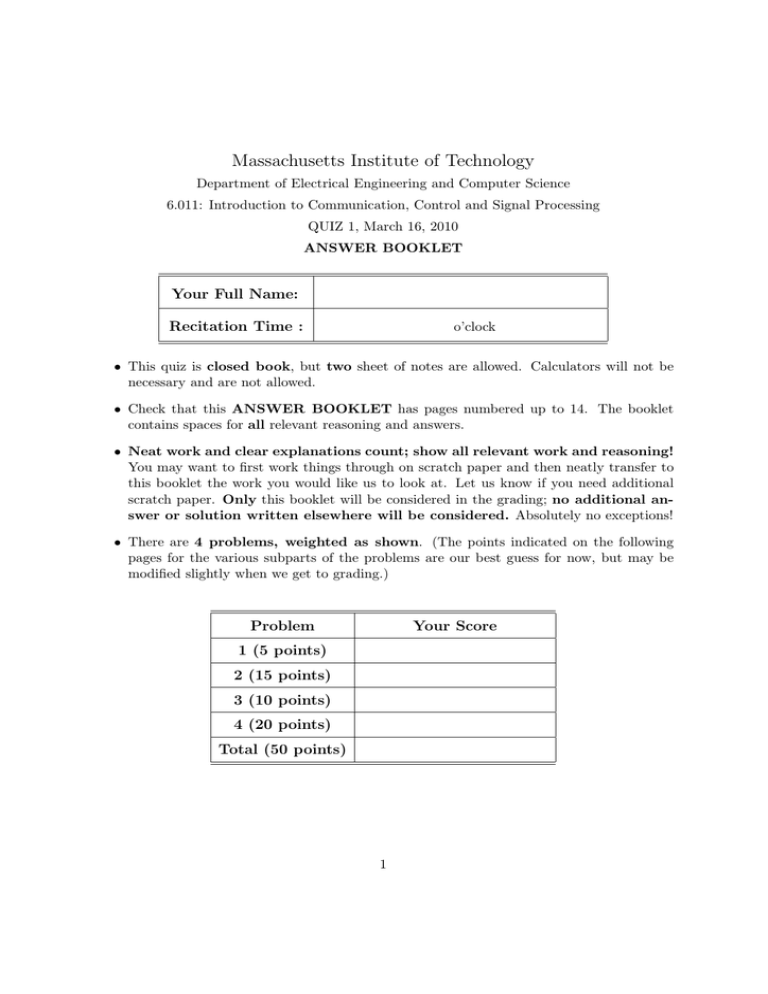
Massachusetts Institute of Technology
Department of Electrical Engineering and Computer Science
6.011: Introduction to Communication, Control and Signal Processing
QUIZ 1, March 16, 2010
ANSWER BOOKLET
Your Full Name:
Recitation Time :
o’clock
• This quiz is closed book, but two sheet of notes are allowed. Calculators will not be
necessary and are not allowed.
• Check that this ANSWER BOOKLET has pages numbered up to 14. The booklet
contains spaces for all relevant reasoning and answers.
• Neat work and clear explanations count; show all relevant work and reasoning!
You may want to first work things through on scratch paper and then neatly transfer to
this booklet the work you would like us to look at. Let us know if you need additional
scratch paper. Only this booklet will be considered in the grading; no additional an­
swer or solution written elsewhere will be considered. Absolutely no exceptions!
• There are 4 problems, weighted as shown. (The points indicated on the following
pages for the various subparts of the problems are our best guess for now, but may be
modified slightly when we get to grading.)
Problem
Your Score
1 (5 points)
2 (15 points)
3 (10 points)
4 (20 points)
Total (50 points)
1
Problem 1 (5 points)
H(ejΩ ) = exp{−j(60Ω + 25Ω3 )} for |Ω| < π. In this frequency range,
1(a) (1 point) the magnitude |H(ejΩ )| is:
1(b) (1 point) the phase ∠H(ejΩ ) is:
1(c) (1 point) the group delay τg (Ω) is:
1(d) (2 points) The impulse response h[n] of this filter is given by the plot in (choose A or B
or C or D or E):
Two different features of this response that support choosing it as h[n] are:
2
Problem 2 (15 points)
The deterministic autocorrelation function of x(t) is
� ∞
sin(2τ )
x(t)x(t − τ ) dt = 9
.
Rxx (τ ) =
πτ
−∞
2(a) (3 points) The energy spectral density S xx (jω) of this signal is given by the following —
careful and fully labeled! — sketch:
The energy of the signal, Ex =
�∞
−∞ x
2 (t) dt
, is:
Ex =
(Show in both the time domain and frequency domain how you computed this.)
3
2(b) (2 points) The magnitude of the Fourier transform of x(t), i.e., |X(jω)|, is given by the
following — careful and fully labeled! — sketch (be sure to explain your answer):
2(c) (2 points) One possible signal x(t) that has the specified deterministic autocorrelation
function Rxx (τ ) is:
x(t) =
(Be sure to explain your reasoning!)
4
2(d) (2 points) The relation (in either the time domain or the frequency domain) between any
other answer to 2(c) and the specific one you gave in 2(c):
2(e) (3 points) The x(t) above is the input to an ideal lowpass filter that has gain 1 for
frequencies ω satisfying |ω | < 1, and gain 0 elsewhere. The corresponding output of the
filter is y(t), with energy spectral density S yy (jω) given by the following — careful and
fully labeled! — sketch (be sure to explain your answer):
The energy of y(t), namely Ey , is:
Ey =
5
2(f) (3 points) Suppose another signal f (t) has deterministic autocorrelation function
� ∞
sin(2τ )
Rf f (τ ) =
f (t)f (t − τ ) dt = cos(10τ )
.
τ
−∞
The magnitude of the Fourier transform of the signal, i.e., |F (jω)|, is derived below, and
given by the following — careful and fully labeled! — sketch:
The value of
�∞
−∞ x(t)f (t
− τ ) dt is:
(Explain your reasoning carefully.)
6
Problem 3 (10 points)
Note xc (t) = sin(2πf1 t), with f1 = 1300 Hz.
3(a) (1 point) The minimum value that the sampling frequency 1/T has to exceed, in order to
avoid aliasing at the C/D converter, is:
For each of the following parts, fully specify what the output yc (t) is for the indicated
choice of the sampling/reconstruction frequency 1/T . Show how you obtain your answers!
3(b) (3 points) When 1/T = 8000 Hz, the output yc (t) is:
yc (t) =
7
3(c) (3 points) When 1/T = 4000 Hz, the output yc (t) is:
yc (t) =
3(d) (3 points) When 1/T = 1600 Hz, the output yc (t) is:
yc (t) =
8
Problem 4 (20 points)
�
q̇(t) =
0 1
6 1
�
�
q(t) +
0
1
�
x(t)
y(t) = [ 1 1 ] q(t) .
4(a) (3 points) The eigenvalues and associated eigenvectors are:
λ1 =
v1 =
λ2 =
v2 =
Check your answers carefully!
9
4(b) (1 point) Is the system asymptotically stable? Explain your answer.
4(c) (3 points) The transfer function H(s) of the system is:
H(s) =
What feature of this H(s) tells you the system is reachable and observable?
10
4(d) (4 points) When the initial state of the system is at zero, i.e., when q(0) = 0, and when
the input for t ≥ 0 is x(t) = 5e−t , the output y(t) of the system for t ≥ 0 is
y(t) = e3t − e−2t .
(You can use this fact as a check on some of your preceding answers!) What initial
condition q(0) would we need in order to have y(t) ≡ 0 for t ≥ 0, with this same input
x(t) = 5e−t for t ≥ 0. Be sure to explain your reasoning!
q(0) =
11
4(e) (3 points) Suppose we implement a state feedback control of the form
x(t) = gT q(t) + p(t)
on the given system, where the feedback gain vector is gT = [g1 g2 ], and p(t) is some
new external input. Write down the resulting state-space model, with input p(t), state
vector q(t), and output y(t). You need to show the model in detail, making explicit the
entries of all matrices and vectors involved in the state evolution equation and the output
equation.
⎡
⎤
⎢
⎢
q̇(t)
=
⎢
⎢
⎣
y(t) =
�
12
⎡
⎤
⎥
⎢
⎥
⎢
⎥ q(t) +
⎢
⎥
⎢
⎦
⎣
⎥
⎥
⎥ p(t)
⎥
⎦
�
�
q(t) +
�
p(t) .
4(f) (4 points) For your closed-loop system in (e), determine what choice of g1 and g2 will
result in a closed-loop characteristic polynomial of
ν(s) = s2 + 3s + 2 .
Is the resulting system observable? Be sure to show your reasoning.
g1 =
g2 =
Is the resulting system observable?
13
4(g) (2 points) With the state feedback gains picked as in (f), suppose p(t) in the closedloop system is kept constant at the value p = 6 for all time. What is the corresponding
equilibrium value q of the state vector q(t)?
q=
14
MIT OpenCourseWare
http://ocw.mit.edu
6.011 Introduction to Communication, Control, and Signal Processing
Spring 2010
For information about citing these materials or our Terms of Use, visit: http://ocw.mit.edu/terms.

